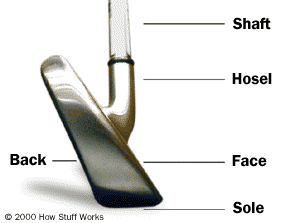The Parts of the Club Head
The head of the golf club has several parts: the hosel, where the head connects to the shaft; the face, which actually strikes the ball; the sole, which is the part closest to the ground; and the back, which is on the side opposite the face. We've talked a bit about the design of the back, and there's not much to say about the hosel, so let's look at the face and the sole.

The Face
When you hear an announcer for a golf tournament talking about the player's selection of a club, you'll generally hear whether the player has chosen a wood or an iron, and then a number. The number is related to the angle at which the face slopes back from vertical when the club is held in its normal position facing the ball. A higher number for the club represents a greater degree of slope away from vertical, generally resulting in a higher, shorter shot. There are some slight variations between manufacturers, but the club numbers and their related slopes generally look like this.
Advertisement
The slope is important for two reasons. First, the face will launch the ball on a path perpendicular to the plane of the face at impact, so a more "laid back" face will start the ball on a higher trajectory. This is crucial when a golfer tries to send the ball over some obstacle, or when the golfer wants the ball to come back down at a steep angle, which tends to result in a shorter roll after landing. The second important aspect of the slope is spin -- the greater the slope, the greater the spin.
In the 450 millionths of a second that the ball and club are in contact the ball does several things. First, it deforms quite a bit, flattening against the face of the club. As the ball begins to rebound to its normal globe shape, it starts to slide up the club face. Finally, just before it leaves the club, the ball returns to its familiar shape and begins to roll up the face. By the time the ball has left the club face, it is spinning quite rapidly. According to the USGA, a ball hit by a wood or one of the longer irons (3 to 5) will be spinning at approximately 3,600 RPM when it leaves the club. The same ball struck by a pitching wedge will spin at nearly 6,000 RPM when it leaves the club.
A spinning golf ball is a good thing because the rapid spin provides aerodynamic lift, causing a spinning ball to travel higher and farther than one with no spin at all. The spinning ball is also less influenced by small gusts of wind, making for a more predictable shot. One of the other features you will notice on the face of a golf club, the grooves, also help provide spin.
The grooves on the face of a golf club serve two purposes. First, they provide just a bit of "bite" for the golf ball as it's sliding up the face, helping it to spin more rapidly. Next, if grass is trapped between the ball and club at impact, the water in the grass will be squeezed out by the nearly 3,000 pounds of force generated by the average swing. Like the tread on an automobile tire, the grooves on the club face give the water somewhere to go so that the ball doesn't skid up the face without spinning.
The Sole
Ideally, the sole of the golf club will minimize the twisting of a bad hit. In woods, the broad, flat sole with rounded edges helps the head glide over the surface of the grass without digging in. Shots using irons tend to take patches of the turf away (the patch is called a divot), so the sole of irons are designed to slice through the turf evenly, without twisting or unexpected tugging to disrupt the golfer's shot.
